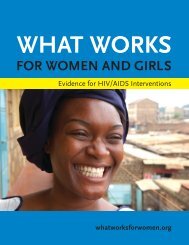Global Tuberculosis Report -- 2012.pdf
Global Tuberculosis Report -- 2012.pdf
Global Tuberculosis Report -- 2012.pdf
You also want an ePaper? Increase the reach of your titles
YUMPU automatically turns print PDFs into web optimized ePapers that Google loves.
Additional highlights by topicBurden of diseaseGeographically, the burden of TB is highest in Asia andAfrica. India and China together account for almost 40%of the world’s TB cases. About 60% of cases are in theSouth-East Asia and Western Pacific regions. The AfricanRegion has 24% of the world’s cases, and the highest ratesof cases and deaths per capita.Worldwide, 3.7% of new cases and 20% of previouslytreated cases were estimated to have MDR-TB.India, China, the Russian Federation and South Africahave almost 60% of the world’s cases of MDR-TB. Thehighest proportions of TB patients with MDR-TB are ineastern Europe and central Asia.Almost 80% of TB cases among people living with HIVreside in Africa.Estimating the burden of TB in children (aged less than15) is difficult; estimates are included in the report for thefirst time. There were an estimated 0.5 million cases and64 000 deaths among children in 2011.Case notifications and treatment successIn 2011, 5.8 million newly diagnosed cases were notifiedto national TB control programmes (NTPs) and reportedto WHO, up from 3.4 million in 1995 but still only twothirdsof the estimated total of 8.7 million people who fellill with TB in 2011.Notifications of TB cases have stagnated in recent years.New policy measures, including mandatory case notificationby all care providers via an electronic web-basedsystem in India, could have a global impact on the numberof TB cases notified in future years. Intensified effortsby NTPs to engage the full range of care providers usingpublic-private mix (PPM) initiatives are also important;in most of the 21 countries that provided data, 10–40% ofnotifications were from non-NTP care providers.<strong>Global</strong>ly, treatment success rates have been maintainedat high levels for several years. In 2010 (the latestyear for which treatment outcome data are available), thetreatment success rate among all newly-diagnosed caseswas 85% and 87% among patients with smear-positivepulmonary TB (the most infectious cases).Responding to drug-resistant TBMeasurement of drug resistance has improved considerably.Data are available for 135 countries worldwide (70%of WHO’s 194 Member States) and by the end of 2012 willbe available from all 36 countries with a high burden ofTB or MDR-TB.Extensively drug-resistant TB, or XDR-TB, has beenreported by 84 countries; the average proportion of MDR-TB cases with XDR-TB is 9.0%.The target treatment success rate of 75% or higher forpatients with MDR-TB was reached by only 30 of 107countries that reported treatment outcomes.Scaling up TB-HIV collaboration<strong>Global</strong>ly, 40% of TB patients had a documented HIV testresult and 79% of those living with HIV were providedwith co-trimoxazole preventive therapy in 2011.Interventions to detect TB promptly and to preventTB among people living with HIV, that are usually theresponsibility of HIV programmes and general primaryhealth-care services, include regular screening for TBand isoniazid preventive therapy (IPT) for those withoutactive TB. The number of people in HIV care who werescreened for TB increased 39% (2.3 million to 3.2 million)between 2010 and 2011. Nearly half a million peoplewithout active TB were provided with IPT, more thandouble the number started in 2010 and mostly the resultof progress in South Africa.Research and development to accelerate progressResearch to develop a point-of-care diagnostic test for TBand MDR-TB continues, and other diagnostic tests are inthe pipeline.Today, standard treatment for TB patients lasts sixmonths and the regimen for most patients with drugresistantTB takes 20 months. Treatment for MDR-TB iscostly and can have serious side-effects. Of the 11 anti-TBdrugs in clinical trials, two new drugs are being evaluatedto boost the effectiveness of MDR-TB regimens. A novelregimen that could be used to treat both drug-sensitiveTB and MDR-TB and shorten treatment duration hasshown encouraging results in clinical trials.There is no effective vaccine to prevent TB in adults.Progress in the past decade means that it is possible that atleast one new vaccine could be licensed by 2020.Financing for TB care and controlAbout US$ 1 billion per year of international donor fundingis needed for TB care and control (excluding TB/HIVinterventions) in low and middle-income countries from2013 to 2015, double existing levels. Up to an additionalUS$ 1 billion per year is needed for TB/HIV interventions,mostly for ART for HIV-positive TB patients.National contributions provide the bulk of financingfor TB care and control in Brazil, the Russian Federation,India, China and South Africa (BRICS). However, theyremain insufficient for scaling up the diagnosis and treatmentof MDR-TB; BRICS account for about 60% of theworld’s estimated cases of MDR-TB.The <strong>Global</strong> Fund provides almost 90% of internationaldonor funding for TB.2 GLOBAL TUBERCULOSIS REPORT 2012
















